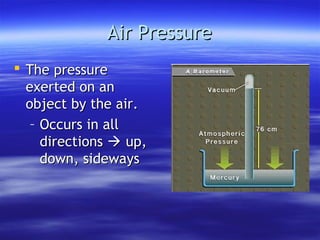
Air pressure
- 1. Air Pressure The pressure exerted on an object by the air. – Occurs in all directions up, down, sideways
- 2. Air Pressure A barometer is used to measure the amount of pressure in the air. – Units = mmHg (millimeters of Mercury) or atm (atmospheres)
- 3. Barometers Rapidly falling pressure almost always means an approaching storm system. Rapidly rising pressure almost always means clearing and cooler weather is ahead.
- 4. Winds Winds are created by horizontal air pressure differences – pressure gradients Uneven heating of the Earth creates pressure differences
- 5. What affects wind? Pressure differences- Cause air to move The Coriolis Effect- causes global winds to be deflected Friction- slows down air, which changes wind direction
- 6. Measuring Pressure Isobars- lines of equal pressure – Much like contour lines, but instead of elevation, they are lines of equal pressure – Are used to predict where weather is moving
- 7. Jet Stream Fast flowing, relatively narrow air currents found just under the tropopause Form at the boundaries of adjacent global wind belts
- 8. Global Winds Global winds are created by the unequal heating of Earth. The equator is much hotter than the rest of Earth, causing an extremely low pressure.
- 9. Global Winds This causes air from adjacent areas to move towards the equator. This movement begins a chain reaction of air movement throughout Earth, creating 6 wind belts.
- 10. High Pressure Zone/Cyclone Occurs when temperatures are cold Little or no moisture (humidity) – The air is heavy and sinks towards Earth’s surface Winds move outward and clockwise around the center of a cyclone
- 11. Low Pressure Zone/Anticyclone Occurs when temperatures are warm Can have large amounts of moisture (humidity) – The air is light and rises upward into the atmosphere Winds move outward and counterclockwise around the center of the anticyclone
- 12. The Coriolis Effect The Coriolis effect is a result of the spinning of Earth. As Earth spins, anything moving in a straight line from North to South will be deflected sideways. – In the Northern Hemisphere, winds, water, and other fluids will be deflected to the right at a 90o angle. – In the Southern Hemisphere, everything will be deflected to the left at a 90o angle.
- 13. Assignment Complete procedure questions for “Air Pressure Demonstration” Identify Types of Energy Transfers Worksheet